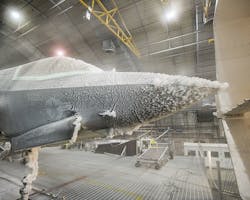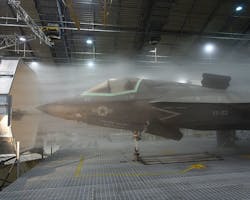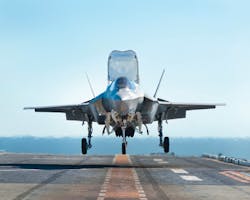EGLIN AFB, Fla., 30 Jan. 2014. Personnel at the U.S. Air Force 96th Test Wing’s McKinley Climatic Laboratory located at Eglin Air Force Base, Fla., have subjected the Lockheed Martin F-35 Lightning II -- a single-seat and single-engine, all-weather stealth multirole fighter jet – rigorous climatic testing over the past four months.
The F-35 Patuxent River Integrated Test Force in Maryland ferried aircraft BF-05 to Eglin Air Force Base, Florida to undergo climatic testing at the 96th Test Wing's McKinley Climatic Laboratory. During the six-month test, the F-35s will be exposed to extreme wind, solar radiation, fog, humidity, rain intrusion/ingestion, freezing rain, icing cloud, icing build-up, vortex icing and snow. (Photo by Michael D. Jackson, F-35 Integrated Test Force)
An F-35B military aircraft from the F-35 Patuxent River Integrated Test Force in Maryland has endured extreme weather temperatures during tests designed to certify the fleet for deployment in any corner of the world.
With 13 countries currently involved with the program, the F-35 must be tested in meteorological conditions representative of those locations from which it will operate -- ranging from the heat of the Australian Outback to the bitter cold of the Arctic Circle above Canada and Norway. The McKinley Climatic Laboratory at Eglin Air Force Base in Florida supports all-weather testing of weapon systems to ensure they function regardless of climatic conditions.
“We’ve designed an environment at the chamber where we can simulate virtually any weather condition—all while flying the jet at full power in either conventional or vertical takeoff mode,” affirms Dwayne Bell, McKinley Climatic Laboratory technical chief.
An icing cloud test calibration fixture is shown in front of an F-35B Lightning II aircraft as it undergoes cold weather testing at the 96th Test Wing's McKinley Climatic Laboratory at Eglin Air Force Base, Florida. (Photo by Michael D. Jackson, F-35 Integrated Test Force)
The F-35B Lightning II was ferried to Eglin AFB in September 2014 to begin a six-month assessment of the aircraft’s performance under a variety of environmental conditions, including: wind, solar radiation, fog, humidity, rain intrusion/ingestion, freezing rain, icing cloud, icing build-up, vortex icing, and snow.
“While we are testing in the world’s largest climatic testing chamber, we’re pushing the F-35 to its environmental limits — ranging from 120 degrees Fahrenheit to negative 40 degrees, and every possible weather condition in between,” explains F-35 test pilot Billie Flynn, who performed extreme cold testing on the aircraft.
“To this point, the aircraft’s performance is meeting expectations,” Flynn adds. “It has flown in more than 100 degree heat while also flying in bitter subzero temperatures. In its final days of testing, it will fly through ice and other conditions such as driving rain with hurricane force winds.
“We are learning more and more about the aircraft every day,” Flynn says. “The future warfighters can be confident the F-35 will perform in any condition they find themselves in for the future.”
An F-35B Lightning II undergoes ice evaluation testing at the 96th Test Wing's McKinley Climatic Laboratory at Eglin Air Force Base, Florida. (Photo by Michael D. Jackson, F-35 Integrated Test Force)
The F-35 Lighting II is a multi-role, multi-service, single-seat, single-engine strike fighter featuring next-generation stealth technology. By delivering 5th Generation airpower essential to our mutual security strategy, the F-35 is a single solution that yields multi-dimensional capabilities to defeat 21st Century threats and enables joint and coalition partners to conduct shoulder-to-shoulder operations in future conflicts.
The F-35 Lightning II has surpassed 25,000 combined flight hours with 16,200 hours in the F-35 military fleet aircraft and 8,950 hours of System Development and Demonstration (SDD) testing. To date, 158 F-35 pilots and more than 1,650 maintainers have graduated from training at Eglin AFB. The F-35 has completed multiple weapons tests as well as F-35B and F-35C first-life durability testing; the test fleet has conducted two F-35B sea trials aboard the USS WASP (LHD 1), and last November the F-35C completed its first sea trial aboard USS NIMITZ (CVN 68).




